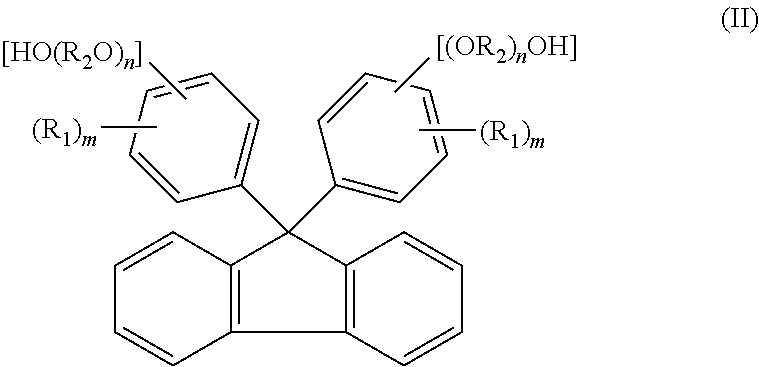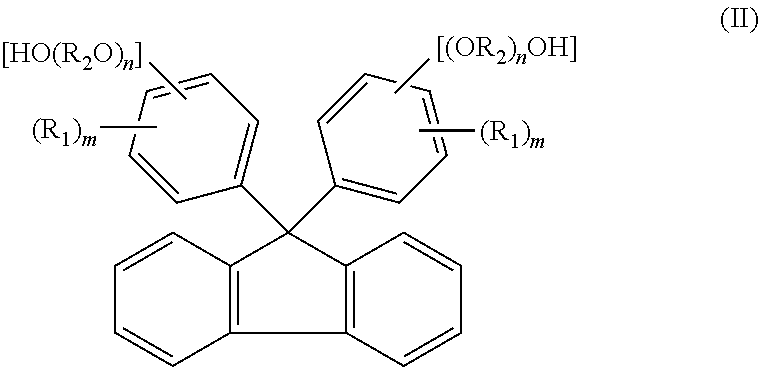Method for producing fluorene derivative
- Summary
- Abstract
- Description
- Claims
- Application Information
AI Technical Summary
Benefits of technology
Problems solved by technology
Method used
Image
Examples
example 1
[0151]A reaction was carried out by (a) feeding 40.0 g of fluorenone, 306.7 g of 2-phenoxyethanol, 160 g of toluene, and 1.0 g of tungstophosphoric acid into a 500 ml glass reactor vessel equipped with a stirrer, a condenser and a thermometer, and (b) stirring a mixture under toluene reflux for 8 hours. The amount of remaining fluorenone was determined by HPLC, and found to be 0.1% or less. To an obtained reaction mixture liquid, 1.0 g of 29% sodium hydroxide aqueous solution was added, and thereafter toluene and 240.0 g of 2-phenoxyethanol were distilled away by concentration under reduced pressure. To an obtained concentrated liquid, 280 g of toluene and 60 g of water were added, and the mixture liquid was stirred at 80° C. Thereafter, an aqueous phase was separated and removed, and a target substance partitioned in an organic phase was recovered. A separated waste water was analyzed, and it was found that a total organic carbon (hereinafter referred to as TOC)=850 mg / L, chemical ...
example 2
[0153]The same operations as in Example 1 were repeated except that, after the reaction was carried out in the same manner as in Example 1, 0.9 g of 50% potassium hydroxide aqueous solution was added to an obtained reaction mixture liquid instead of 1.0 g of 29% sodium hydroxide aqueous solution. In this way, 76.5 g of 9,9-bis(4-(2-hydroxyethoxy)phenyl)fluorene (yield: 78.5%, LC purity 98.5%) was obtained. Obtained 9,9-bis(4-(2-hydroxyethoxy)phenyl)fluorene was dissolved by heat at 230° C. for 2 hours. The 9,9-bis(4-(2-hydroxyethoxy)phenyl)fluorene thus dissolved show a hue of 100 in APHA. A separated waste water was analyzed, and it was found that TOC=920 mg / L, COD=3100 mg / L, BOD=250 mg / L, and phenol content=0.1 mg / L or less.
example 3
[0157]A reaction was carried out by (a) feeding 23 g of fluorenone, 1.3 g of dodecyl mercaptan, and 161.0 g of 2-methyl phenol into a 500 ml glass reactor vessel equipped with a stirrer, a condenser and a thermometer, (b) dropping 13.0 g of 35% hydrochloric acid to a mixture, and (c) stirring the mixture at 50° C. for 2 hours. The amount of remaining fluorenone was determined by HPLC, and found to be 0.1% or less. To an obtained reaction mixture liquid, 18.5 g of 29% sodium hydroxide aqueous solution was added, and thereafter 94.0 g of 2-methyl phenol was distilled away from an organic phase by concentration under reduced pressure. To an obtained concentrated liquid, 161 g of toluene and 23 g of water were added, and the mixture liquid was stirred at 80° C. Thereafter, an aqueous phase was separated and removed, and a target substance partitioned in the organic phase was recovered. The organic phase was further washed twice with 23 g of water, and cooled to 10° C. Then, precipitated...
PUM
| Property | Measurement | Unit |
|---|---|---|
| Temperature | aaaaa | aaaaa |
| Temperature | aaaaa | aaaaa |
| Temperature | aaaaa | aaaaa |
Abstract
Description
Claims
Application Information
 Login to View More
Login to View More - R&D
- Intellectual Property
- Life Sciences
- Materials
- Tech Scout
- Unparalleled Data Quality
- Higher Quality Content
- 60% Fewer Hallucinations
Browse by: Latest US Patents, China's latest patents, Technical Efficacy Thesaurus, Application Domain, Technology Topic, Popular Technical Reports.
© 2025 PatSnap. All rights reserved.Legal|Privacy policy|Modern Slavery Act Transparency Statement|Sitemap|About US| Contact US: help@patsnap.com



